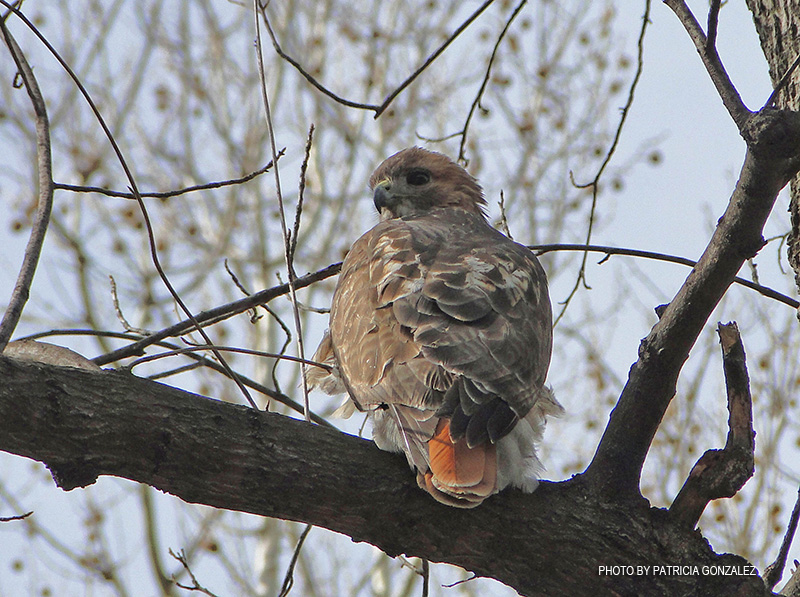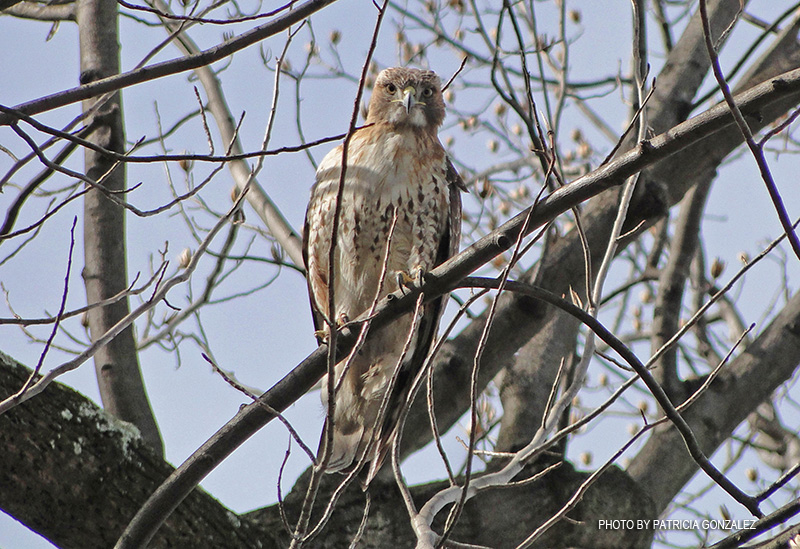Morning Eye Candy: Tree & Moon
Posted in Photography on February 18 2011, by Plant Talk
Catching the last rays of late-winter sun.
(photo by Ivo M. Vermeulen)

Inside The New York Botanical Garden
Posted in Photography on February 18 2011, by Plant Talk
Catching the last rays of late-winter sun.
(photo by Ivo M. Vermeulen)
Posted in Members, Wildlife on February 15 2011, by Patricia Gonzalez
| Patricia Gonzalez is an NYBG Member and avid amateur wildlife photographer. She is especially fond of taking photographs at the Garden. |

Nestled in a corner of the North Bronx is an oasis of trees, plants, and flowers. For many in the borough, The New York Botanical Garden is an escape from the daily grind of living in New York City. Although it is known primarily as a museum of plants, the garden is also teaming with wildlife: Squirrels, rabbits, chipmunks, muskrats, and other creatures make their home there, and so do many species of birds. Two of those birds, Rose and Vince, have become celebrities amongst the wildlife photographers and bird-watchers that regularly frequent the Garden’s 250 acres.

Rose and Vince are red-tailed hawks. Rose was a celebrity long before she built a nest at the Botanical Garden in 2009. She and Hawkeye, her first mate, had made their home on the Fordham University campus back in 2005 where they built a nest in an old oak tree and had two chicks. In 2006 they moved on to a ledge of one of the campus buildings (Collins Hall) where they had three more offspring. Success followed in 2007 and 2008 where they would have three chicks each year.
Rose was named after the Rose Hill Campus of Fordham. Hawkeye was named after Hawkeye Pierce, the character played by Fordham alum Alan Alda on the M.A.S.H. television series. Both hawks were named by James McCabe, Director of the Fordham Library.
Rose and Vince head for the Garden! But for how long will they stay?
Posted in Photography on February 4 2011, by Plant Talk
More scenes from the ice storm.
All photos by Ivo M. Vermeulen
Posted in Photography on February 1 2011, by Plant Talk
It’s been a few weeks since we announced a Photo Contest as part of Caribbean Garden, a reinterpretation of the permanent collection inside the historic Enid A. Haupt Conservatory. We’ve hit a few bumps along the way logistically, but that hasn’t effected the quality of the photos that you have entered! There are several weeks left in the contest, and another winter storm has barreled into the city to welcome February, so come enjoy the warmth of the Conservatory and snap a few pictures while you’re here!
To get you excited about participating, here are a few of the winners from the previous weeks’ contests.
Head below the jump to see the winners from the past two weeks of the contest!
Posted in Wildlife on January 25 2011, by Plant Talk
| Chris Nagy is a Ph.D. student at CUNY, and a wildlife biologist at the Mianus River Gorge Preserve in Bedford, N.Y. |
 In December I had the opportunity to survey The New York Botanical Garden for Eastern Screech-Owls. I have been chasing Eastern Screech-Owls in the Bronx and Manhattan for nearly 7 years, as part of my Ph.D. research, and getting the chance to look for them in the Garden was a treat.
In December I had the opportunity to survey The New York Botanical Garden for Eastern Screech-Owls. I have been chasing Eastern Screech-Owls in the Bronx and Manhattan for nearly 7 years, as part of my Ph.D. research, and getting the chance to look for them in the Garden was a treat.
The easiest way to look for owls, if you’re willing to wander through the woods at night, is to play recordings of their vocalizations. Most owls communicate primarily through calls, and if there’s an owl nearby, it will probably call back when it hears your broadcast.
There have been no reports of Screech-Owls at the Garden for many years, and we didn’t find any this time either. (Ed. note – Though we have no Eastern Screech-Owls, the Garden is home to at least one Northern Saw-Whet Owl and a family of Great Horned Owls). But determining the places where owls are not is just as important as finding where they are.
By comparing the geographic location, habitat characteristics, and other variables in places where they are found versus where they are not, we can determine what features are important for a species. My hunch is that the absence of Eastern Screech-Owls at the Botanical Garden has more to do with the Garden’s location within the larger city than with any specific habitat quality. Alternatively, there also may be larger raptors at the Garden discouraging the smaller Screech Owls from readily calling back, or from making the Garden their home at all.
I’d like to thank NYBG staff, especially Jessica Arcate Schuler, for their help and allowing me to perform some of my research at the Garden.
Posted in Photography on January 18 2011, by Plant Talk
This flame vine sure is beautiful, but is known for being quite aggressive. Grow with care.
Pyrostegia venusta Flame Vine (photo by Ivo M. Vermeulen)
Posted in Photography on January 17 2011, by Plant Talk
Even the flowers on this jade plant look as if they might be carved in the beautiful stone.
Crassula ovata Jade Plant (photo by Ivo M. Vermeulen)
Posted in Photography on January 15 2011, by Plant Talk
Our newest exhibition opens today, complete with a photography contest! Here’s a snapshot to get you in the mood.
In the Conservatory: Caribbean Garden (photo by Ivo M. Vermeulen)
Posted in Programs and Events on January 14 2011, by Sonia Uyterhoeven
 |
Sonia Uyterhoeven is Gardener for Public Education.
|
The Garden will be screening A Sea Change: Imagine a World Without Fish on Saturday, January 22 at 2 p.m. to be followed by a moderated discussion with the director and narrator. Admission is free to all Garden visitors. Stop by any ticketing booth on-site to pick up your complimentary ticket.
I watched a new documentary recently that was a powerful and beautiful tutorial on how we educate, how we learn, and how we inaugurate change on a personal level. It was close to my heart since the topic was environmental stewardship.
A Sea Change: Imagine a World Without Fish is a movie about how the increase in carbon emissions and the raising level of acidity is affecting ocean life. It is a movie that will be enjoyed and should be seen by everyone.

The film is the story of a man, retired history teacher Sven Huseby, who is touched by Elizabeth Kolbert’s New Yorker article*, ”The Darkening Sea.” Kolbert’s article spurs Huseby to go on a quest to investigate what is happening to our oceans. Woven into Huseby’s journey is the tale of his relationship with his grandson and a concern for future generations. It poses several important questions: What is our connection with the natural world? What kind of world will our children inherit? What kind of values can we instill in young minds?

On Saturday, January 22 The New York Botanical Garden will show the film at 2pm in the Ross Lecture Hall. The screening will be followed by a moderated discussion with the director, Barbara Ettinger, and the narrator, Sven Huseby.
Children of all ages, including their parents, will be inspired to learn more. Young adults, especially those with an interest in social responsibility, will be fascinated by the breathtaking images of the sea. Grandparents will contemplate legacy as they join Huseby’s journey with his grandson into the natural world.

A Sea Change: Imagine a World Without Fish doesn’t proselytize; it is personal and positive with a strong message of social responsibility. It focuses on the wonders of the natural world and how we need to plan for the future as it examines the implication of increasing pollution.
Please join us for an inspiring, enjoyable afternoon.
*To view the entire article by Kolbert, a digital subscription to the New Yorker is required.
Posted in Learning Experiences on January 13 2011, by Plant Talk
 A good lecture can serve as a catalyst for change, and this year’s 11th Annual Winter Lecture Series at The New York Botanical Garden should send you away with a lot to think about, and some serious tools for precipitating change in your own community, city, or just our own backyard.
A good lecture can serve as a catalyst for change, and this year’s 11th Annual Winter Lecture Series at The New York Botanical Garden should send you away with a lot to think about, and some serious tools for precipitating change in your own community, city, or just our own backyard.
The series kicks off on Thursday, January 20 with Michael Van Valkenburgh‘s ”Plants Make Places.” Van Valkenburgh, a renowned landscape architect, will discuss the role of plants in recent projects at Princeton University, Teardrop Park in lower Manhattan, and Brooklyn Bridge Park.
On Thursday, February 17, garden designer, award-winning author, photographer, naturalist, and
 teacher C. Colston Burrell will talking about ”Native Plants and Ecological Design.” Burrell will explore what actually makes a plant ”native,” the definition of ecological gardening, and the issues surrounding sustainable landscape design.
teacher C. Colston Burrell will talking about ”Native Plants and Ecological Design.” Burrell will explore what actually makes a plant ”native,” the definition of ecological gardening, and the issues surrounding sustainable landscape design.
Last, but certainly not least, Annie Novak, urban farming evangelist and director of The New York Botanical Garden’s Children’s Gardening Program will ”Raise The Roof!” on Thursday, March 17. Novak is the founder and director of Growing Chefs field-to-fork education program, and the co-founder of Eagle Street Rooftop Farm in Greenpoint, Brooklyn and will discuss the challenges, successes, and lessons learned from farming the skyline.
 The lectures are being held at the Garden in the Ross Lecture Hall 10 a.m. – 12 p.m. Each lecture is $39 for non-members, and $35 for Members, or buy the whole series and save 10%.
The lectures are being held at the Garden in the Ross Lecture Hall 10 a.m. – 12 p.m. Each lecture is $39 for non-members, and $35 for Members, or buy the whole series and save 10%.
And while you’re at the Garden, why not make a full day of it? Visit Caribbean Garden for a mini-vacation in the historic Enid A. Haupt Conservatory; snap a few pictures to enter into our photography contest; grab a bite from one of our two cafes dedicated to sustainable, local, tasty cuisine; and shop the Winter Sale at the Shop in the Garden.